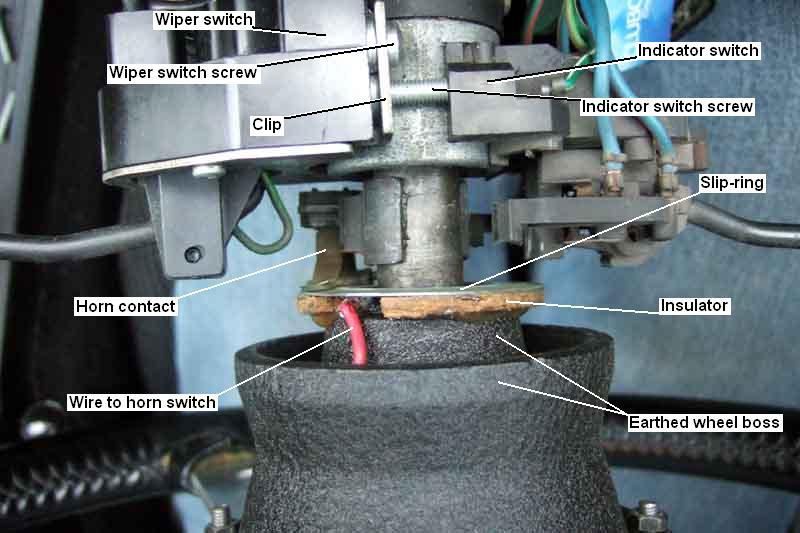North American Mk1, and up to and including 1969 (other markets): The brush rubs on a brass cylinder (slip-ring) attached to the column, but insulated from it. A wire comes from the slip-ring up through the centre of the column to a ball-shaped end ('bullet' below). This presses on a brass contact attached to the middle of the horn push. Operating the horn push connects the brass contact to a metal plate which secures the horn push to the wheel. The wheel and this metal plate are at earth potential, so when the brass contact touches it the horns sound. This series of photos are from John Minchin:
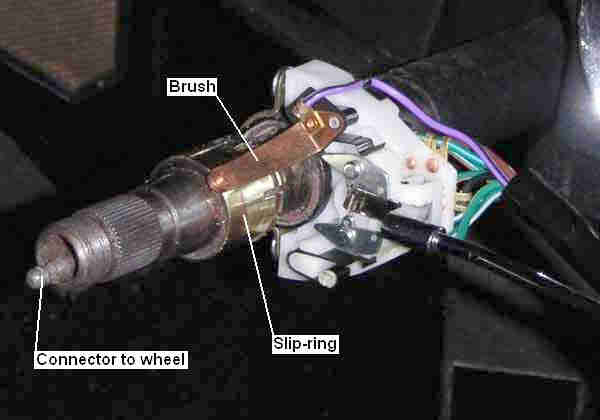
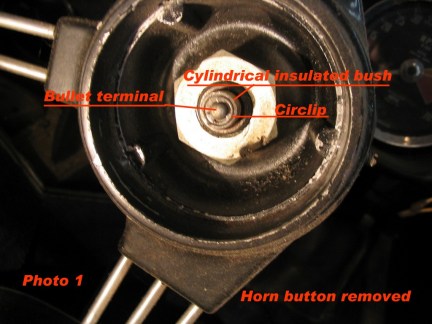
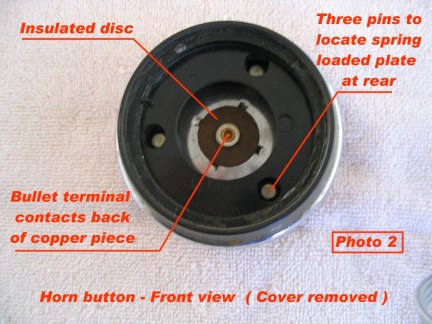
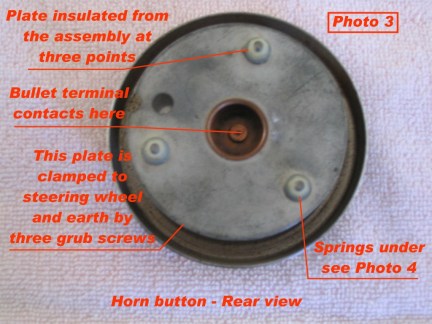
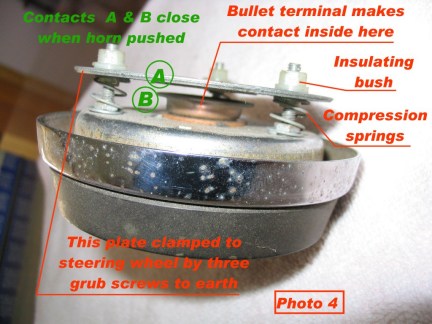
This ebay item shows the column gubbins more clearly. The box describes it as a slip-ring, although the slip-ring itself isn't shown, just the split plastic sleeve it slides over, and the wire that connects it up to the 'bullet' at the end of the column, part number 27H3387. The cylindrical brass slip-ring that fits round the plastic part is 27H5401, both Not Currently Available:
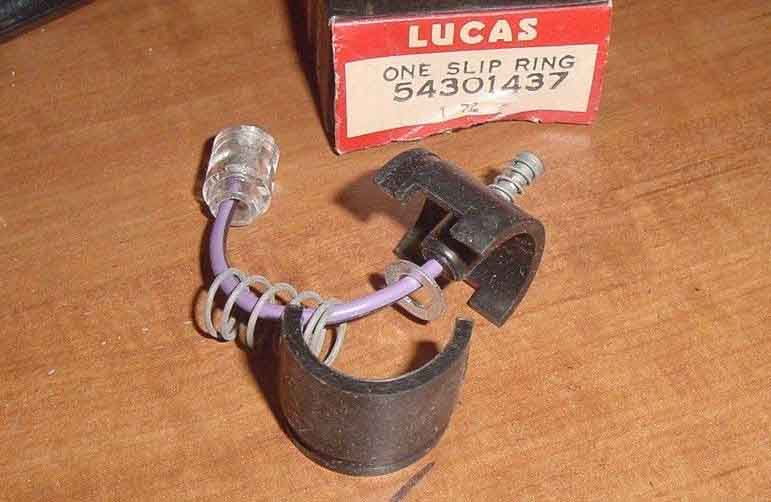
71-on: This is the brush (UK single stalk) 37H8051 on CB cars, fixed to the column outer, and rubbing on the brass slip-ring on the back of the wheel as it is turned:
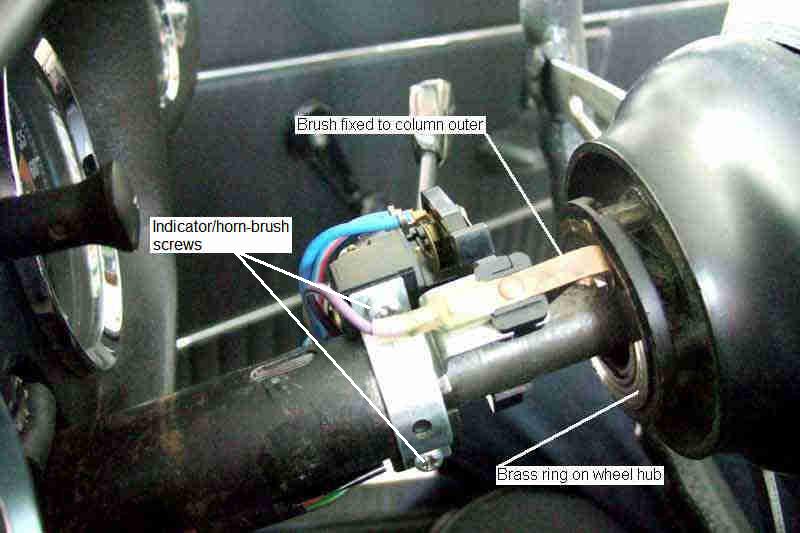
71-on CB 37H8051 on the left, RB until 1977 37H8102 (for twin stalks) on the right: (Moss Europe)
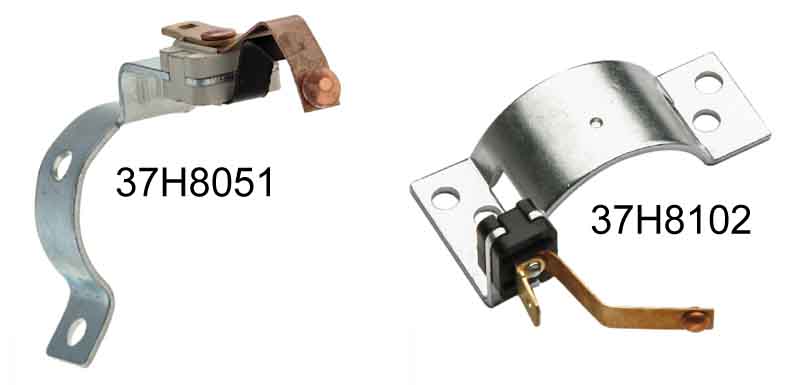
August 2020: As you can see these have copper pips on the end which rub on the brass slip-ring on the wheel, hopefully silently. However these can fall out and the copper spring then makes a loud scraping noise against the slip-ring. I eventually lost Bee's so put a dome-head screw and nut in its place, which worked fine for very many years until it started squeaking again. Put a spot of grease on which worked but squeaked again after a year or so, so really I ought to bite the bullet and replace it. But when someone asked about this very problem on the MG Enthusiasts forum just a few days ago Chris @ Octarine Services said he just put a blob of solder on the end of the spring, so worth a go. Initially it just flowed round the hole, but dabbing more on eventually filled the hole and made a dome-shape, so we shall see. But along the way the steering was clonking, which looks like the off-side track-rod moving laterally as well as in and out with the steering, so that will need investigating. New racks are c£200 and reconditioned £100, but the quality of the latter in two recent cases has been appalling, and there have been cases of new grease-filled racks from Argentina not even being assembled correctly.
August 2021: A while ago it started squeaking again, solder gone flat, so put a bit of grease on. Then at the pre-MOT check the horn wasn't working which turned out to be a build-up of grease between the slip-ring and the contact insulating the two. I had used copper-grease, and I note elsewhere that I had used it on heater dash controls and it got very sticky and made them stiff, so best kept for bolt threads. I'll have to get a new contact next time I buy anything ... unless I can find a little copper button in my tin of nut, screws, washers and bolts. What I actually found was a contact button on the end of a little copper strip, which I soldered to the original copper brush arm over the hole for the missing button.
Slip-ring BHA5042. I've not found the screws for this listed anywhere, and checking one from both Bee and Vee against taps they have a very coarse thread for their diameter. D A Jenkins in Australia wrote on the MG Enthusiasts forum that a new slip-ring came without a tapped thread in the (plastic) holes, so I suspect they are self-tappers of some kind, but without a point or other specially-shaped tip. He tapped them for a 6-32 UNC screw by 3/4" long. Incidentally arrowed is the hole for the sprung 'pencil' (it's not a brush) that connects the back of the slip-ring to the horn push: (Moss Europe)
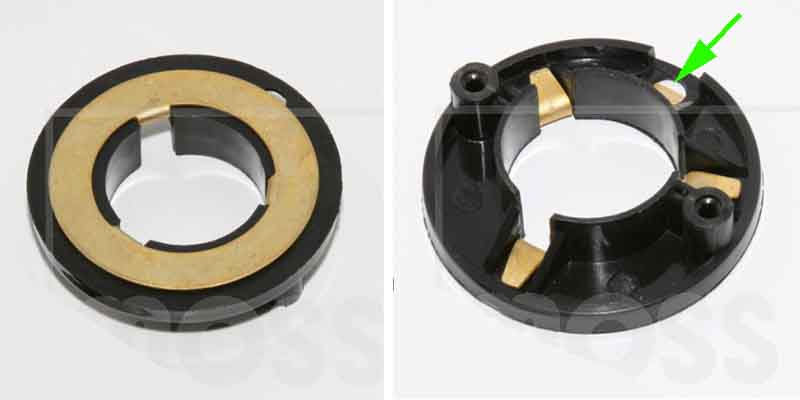
May 2021: Andy Robinson gets one from the MGOC and it has no hole for the sprung 'pencil' (should be where the red arrow is) that connects the back of the slip-ring to the horn-push. Their eBay site clearly shows the hole, but it wouldn't be the first time that images are not fully (or even partially) representative of current stock:
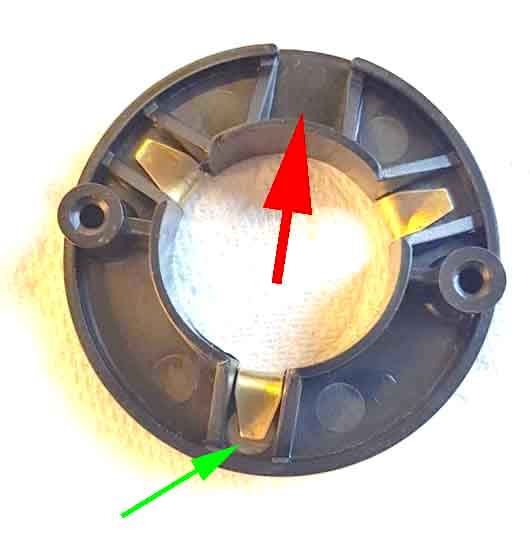
He sent that back and bought another from a different supplier and surprise surprise it was the same. Then he noticed it did have a hole, but on the other side of the plastic moulding. Partially concealed by the bottom slip-ring tab (green arrow) and it was only looking again I saw it on Andy's original photo above. Originally I suggested he could drill one where it should be, but cutting the tab back might also be enough. The recess is narrower there than the correct place, but as the longer springy end of the pencil should be facing the slip-ring that probably wouldn't matter.
Wheel and horn push showing the various components:

... it should be fitted with the fixed contact facing outwards so the insulating sleeve can prevent the contact touching the horn push body as it is fitted or if it is twisted once fitted. Update March 2010: Tim Schorn queried this saying he fitted a new one this way round and it very quickly broke, adamant I had it wrong. This has to be a faulty part, once fitted it only ever operates in compression. Not only is this logically the correct way round but Moss (Europe and US) and the Leyland Parts Catalogue all show it this way round. Also John Twist says "The longer piece should go in there first" and shows it compressing before refitting it at 0.55 here. Tim says he paid $43(US) for this part, in which case he was robbed as they are only £8/$12 at Moss, even less elsewhere:

The component parts of the pencil (BHA 5041):
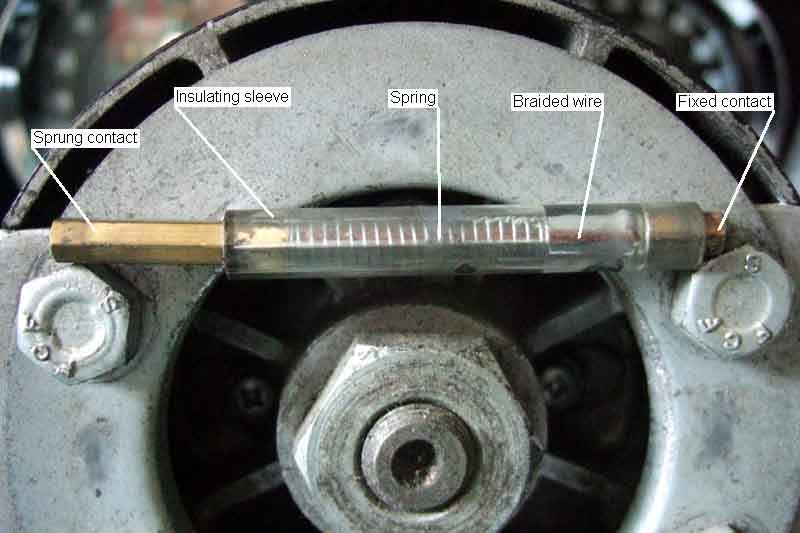
April 2019: Discovered the horn was only sounding when depressed at a particular point, so an opportunity to dismantle this type. Three screws through the grey part and springs into bosses in the rubber cover:
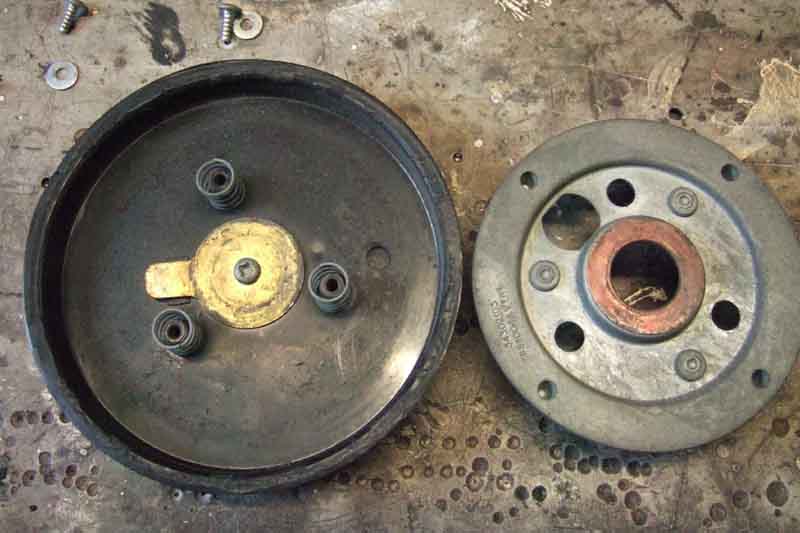
Brass contact on the rubber part and copper on the grey part pretty manky after 45 years:
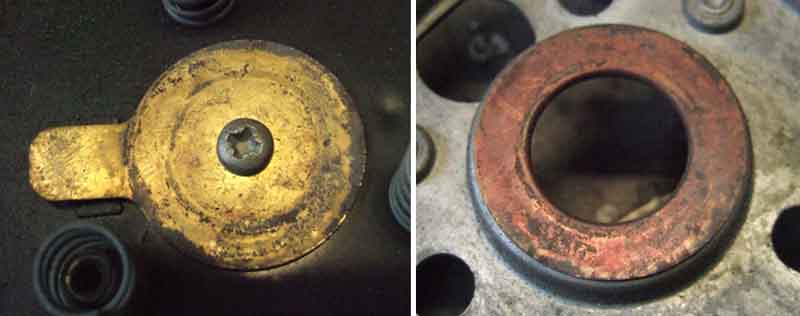
The brass contact can also be unscrewed, note the location ribs in the rubber:
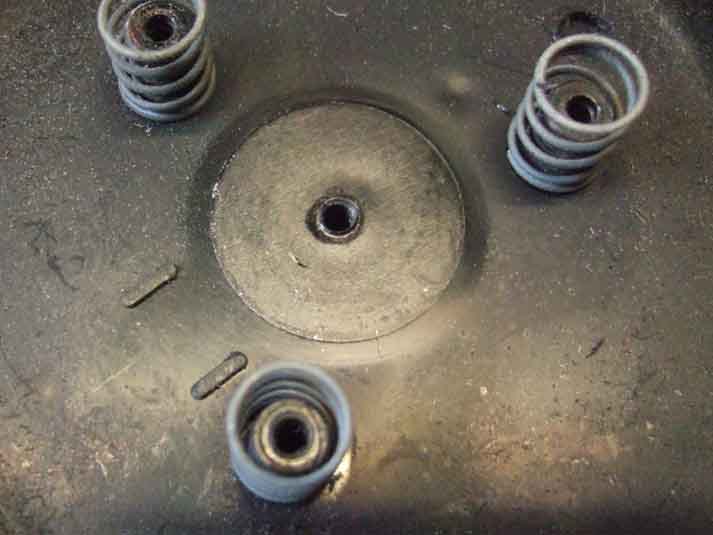
Cleaned up with fine wire wool and reassembled, horn sounds all the way round now:
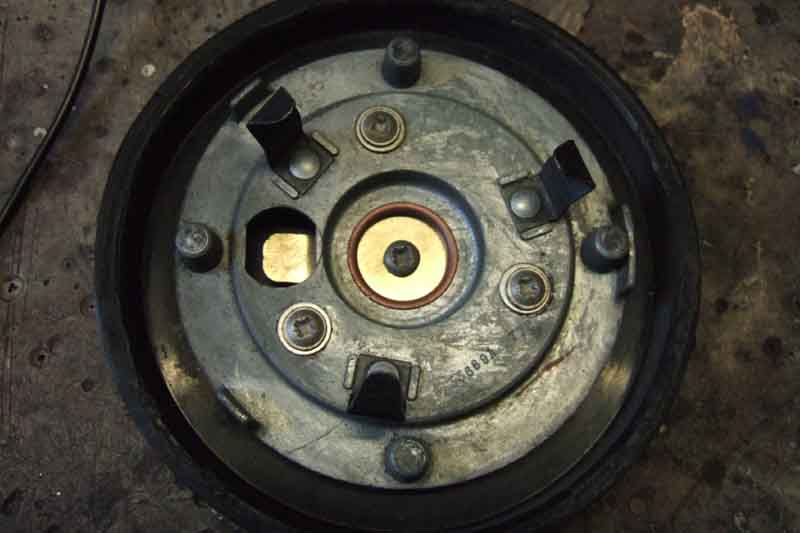
Twin-stalk models to the end of the 76 model year: There is a very small clearance between the indicator cancelling collar and the horn contact, Paul Bulley reports that his has broken in the past and been soldered back on, which has probably shortened it, and the horn sounds as the wheel is turned! Note this is with a Moto-Lita wheel so the contact has been 'adjusted' somewhat to suit:
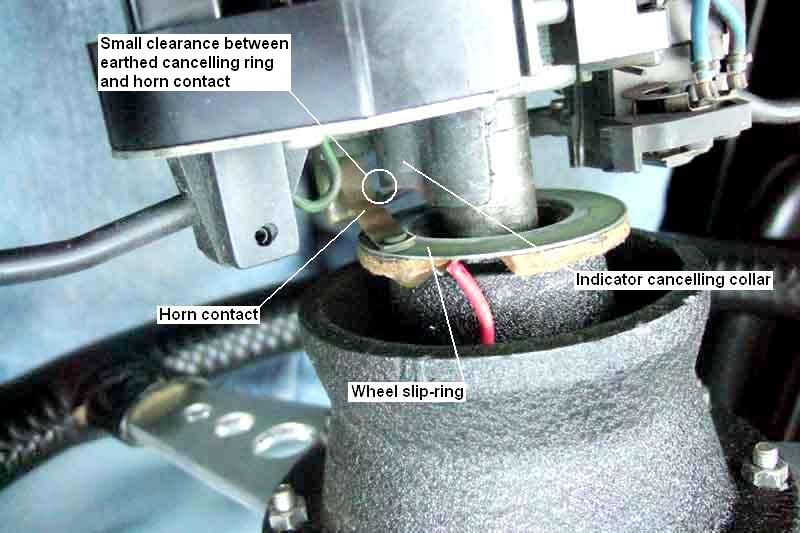
The horn contact is riveted to an extension of the stalk switch clamp plate (via an insulator). Both stalks use the same clamp plate, the indicator switch (on the right) being clamped to the column first, the wiper switch then being screwed to the clamp plate:
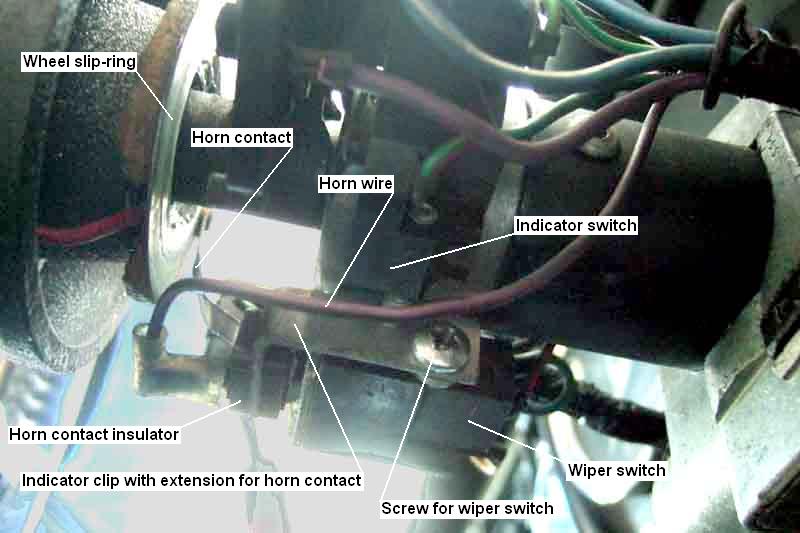
The horn contact/brush for twin-stalk RB cars prior to the 77 model year is 37H8102 (right) and is different to the single-stalk CB version (left):

This is Michael Calandrino's 1974 (I think) US spec with a Mountney wheel. It shows a bracket with the offset holes, but horn contact is on the other side and also at a different angle to my (twin stalk) V8. It took me a while to realise that this is because LHD cars have the indicator switch on the left and the wiper/OD switch on the right!
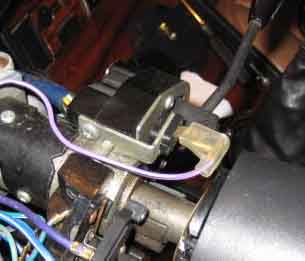
The Moto-Lita wheel on my 75 V8:
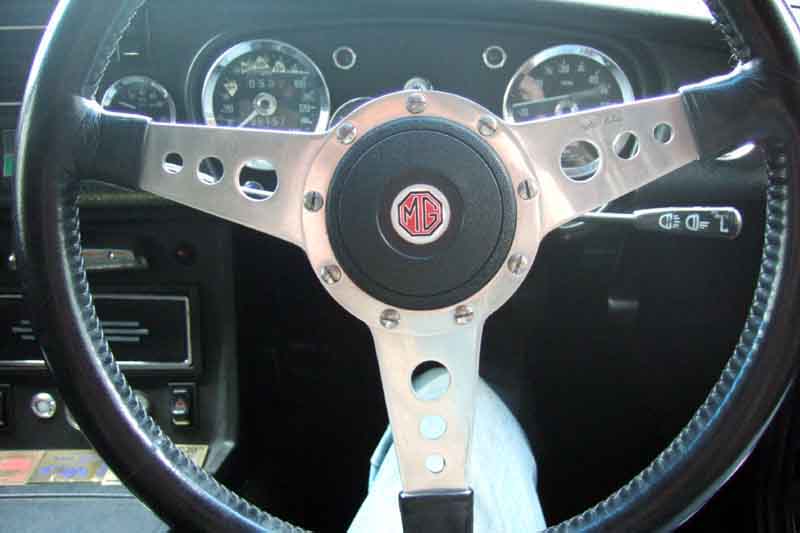
And its connection arrangement. The wire coming out of the hub is 'permanently' attached to the back of the brass ring, but can be removed from the horn-push itself by undoing the nut securing the wire tag (to allow fitting of horn-pushes with different logos). This horn-push only has a single earthing/grounding spring, which means if you look carefully it sits very slightly offset in the hole in the hub. There is no arrangement to make the logo sit square in the wheel, it has to be twisted manually to suit. The actual switch contacts are concealed, and unlike the factory wheel (which has screws) this wheel can only be opened up by prising the spire-clips off the plastic pegs - something which must be done with great care if the pegs are not to break. All a bit cheap:
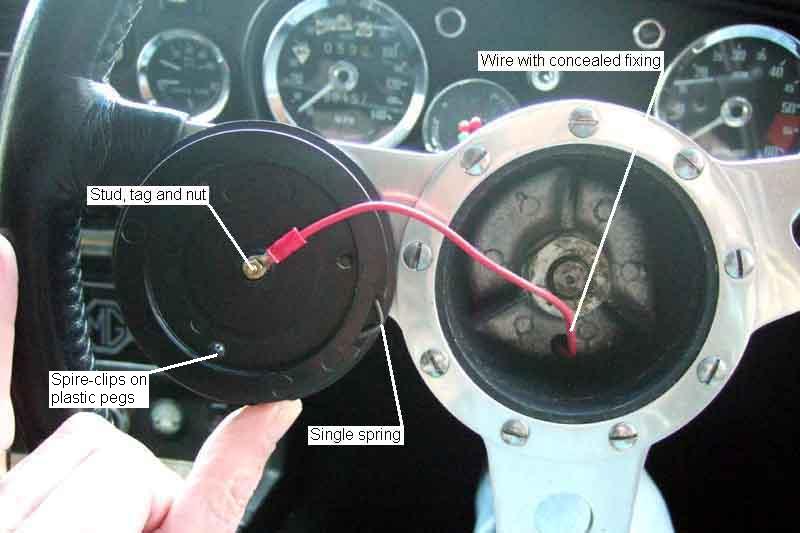
The pretty manky arrangement behind the Moto-Lita wheel. The slip-ring seems to be simply glued to the insulator which is glued to the back of the boss. This also clearly shows the single double-width clip which clamps to the column with the indicator switch, then the wiper switch is screwed to the clip:
